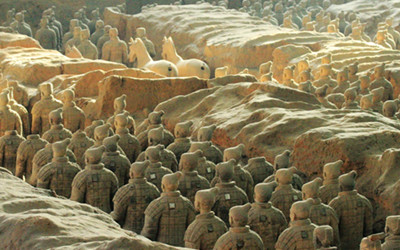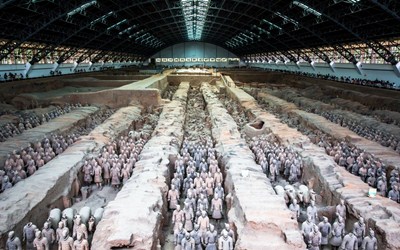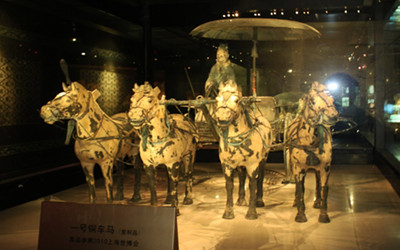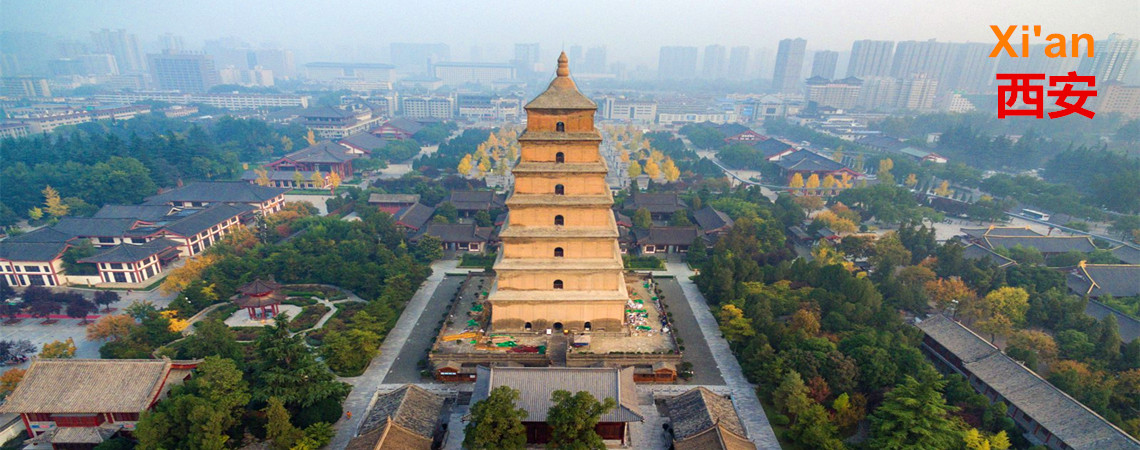
Terracotta Warriors Museum is located 1.5 kilometers (1 mile) east of the Mausoleum of the First Qin Emperor. The Qin Terracotta Army Museum, built at the original excavating place, is a hangar-like construction over Pit 1 and was officially opened in 1979. Later in October 1994, Pit 2 opened to the public. Now the museum is a stunning attraction that every visitor to China should see.The Terracotta Warriors Museum was listed as the World Heritage in 1987.
How to find?
Terracotta Warriors Museum was founded by a group of peasants In 1974. When they was digging a well, they surprisingly unearthed fragments of life-sized terracotta warriors made in
the Qin Dynasty (221BC-206BC), which became the greatest archaeological discovery of the 20th century. The great excavation revealed thousands of warriors and their

horses - an entire army buried for safeguarding the eternity of Emperor
Qinshihuang. Hence, the
Qin Terracotta Army is now over 2,200 years old.
What to see?
The emperor's terracotta army was found in three underground timber lined vaults. The Pit 1 contained chariots and six thousand figures of soldiers; the Pit 2 had fourteen hundred figures of cavalrymen, horses and infantrymen, along with ninety wooden chariots; whilst the Pit 3 contained about seventy figures of warriors. Excavating them has been a massive undertaking.
There are over 8, 000 full-sized warriors and horses and more than 100 chariots been excavated. All of the terracotta warriors were lively made, and from their hair styles, clothes and gestures, it is easy to tell their identities and duties, generals, officers, cavalry or

infantry. There were also over 100, 000 bronze weapons unearthed, which after more than 2,000 years are still sharp and shining, which showed that people had known the metallurgical technology well in the ancient time.
In the Terracotta Warriors Museum, there are two sets of bronze chariots and horses on exhibition, which were excavated to the west of the Mausoleum and are so far the biggest ones unearthed in
China. Because of the limited technology today, most of the excavated warriors and horses have been buried under earth again for better protection and at present there are only 1,000 warriors and horses on exhibition.
Travel Tips
Admission Fee: CNY 150
Opening Hours: everyday from 8:30 am to 5:00 pm (from March 16 to November 14); from 8:30 am to 4:30 pm (from November 15 to Mar 15)
Public Transportation: Bus No. 306 from the railway station goes directly to the Museum every day and the ticket is CMY5 per person. The bus operates from 8:00 am to 6:00 pm.
Notice:
1. The mini-bus at the railway station claiming to be the same as the Bus No. 306 only leaves when it is fully seated, which is not recommended.
2. Taking pictures inside the Museum is acceptable but flashlight is not allowed to use.
3. Shopping for souvenir in the stores near the Museum is not recommended, which will cost you greatly higher than shopping in the city.
4. It is necessary to have a guide for the Bronze Chariots and Horses Hall, where little written information is available for the precious bronzes.

 Terracotta Warriors Museum is located 1.5 kilometers (1 mile) east of the Mausoleum of the First Qin Emperor. The Qin Terracotta Army Museum, built at the original excavating place, is a hangar-like construction over Pit 1 and was officially opened in 1979. Later in October 1994, Pit 2 opened to the public. Now the museum is a stunning attraction that every visitor to China should see.The Terracotta Warriors Museum was listed as the World Heritage in 1987.
Terracotta Warriors Museum is located 1.5 kilometers (1 mile) east of the Mausoleum of the First Qin Emperor. The Qin Terracotta Army Museum, built at the original excavating place, is a hangar-like construction over Pit 1 and was officially opened in 1979. Later in October 1994, Pit 2 opened to the public. Now the museum is a stunning attraction that every visitor to China should see.The Terracotta Warriors Museum was listed as the World Heritage in 1987.  horses - an entire army buried for safeguarding the eternity of Emperor Qinshihuang. Hence, the Qin Terracotta Army is now over 2,200 years old.
horses - an entire army buried for safeguarding the eternity of Emperor Qinshihuang. Hence, the Qin Terracotta Army is now over 2,200 years old.  infantry. There were also over 100, 000 bronze weapons unearthed, which after more than 2,000 years are still sharp and shining, which showed that people had known the metallurgical technology well in the ancient time.
infantry. There were also over 100, 000 bronze weapons unearthed, which after more than 2,000 years are still sharp and shining, which showed that people had known the metallurgical technology well in the ancient time. Ask Questions ?
Ask Questions ?